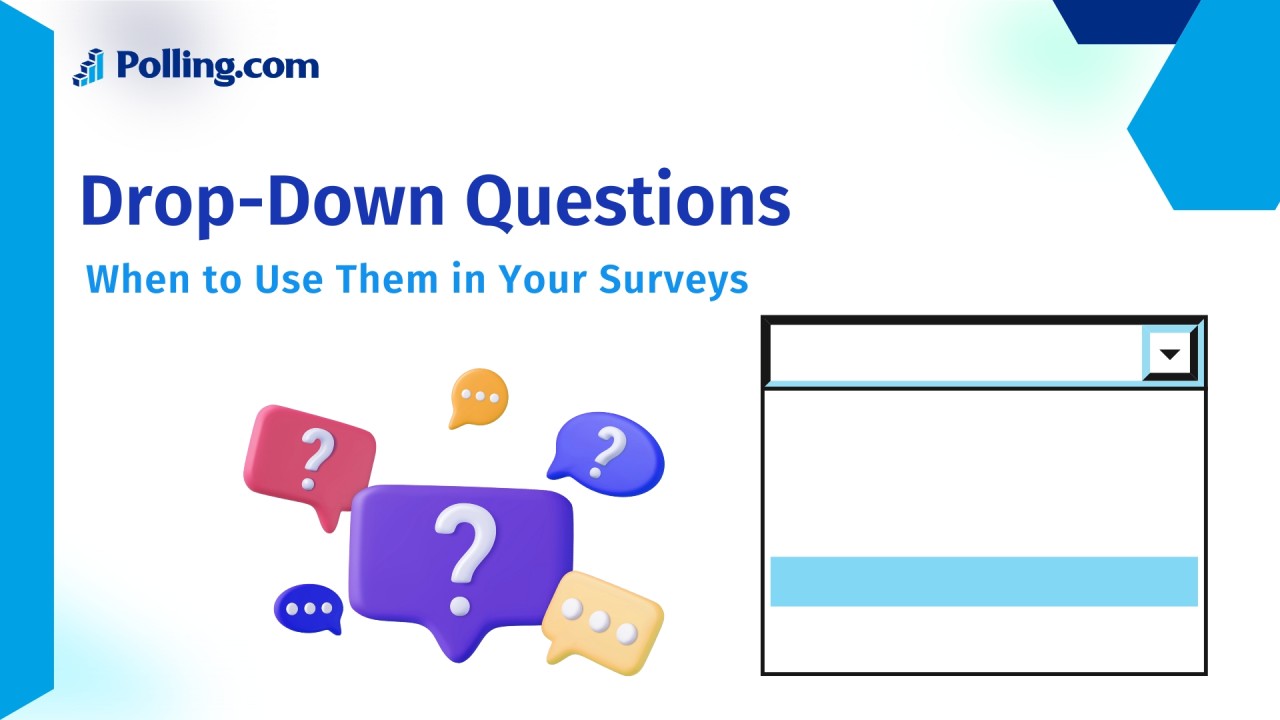
Drop-Down Questions: When to Use Them in Your Surveys
The way you ask questions in a survey can make or break how useful your data turns out, as different types of questions in a survey shape the answers you get from respondents.
Picking the right survey question types isn’t just about style, it’s about getting clear, actionable feedback without confusing anyone or losing their interest.
That’s where drop-down questions come in! They’re a popular pick among question types for surveys, offering a clean way to present options without overwhelming respondents.
Whether you’re running an online poll or digging into demographics, Polling.com’s got your back with flexible, intuitive tools that make crafting drop-down questions and other survey formats a snap, helping you nail survey effectiveness every time.
What Are Drop-Down Questions?
Drop-down questions are a type of closed-ended survey question where respondents pick one answer from a list that pops up when they click, like “What’s your age range?” with options (18-24, 25-34, 35-44) tucked into a tidy menu.
Think of it as a sleeker cousin to other survey answer choices like radio buttons or checkboxes. Drop-downs save space and keep things neat, unlike radio buttons that sprawl out or checkboxes that allow more than one pick.
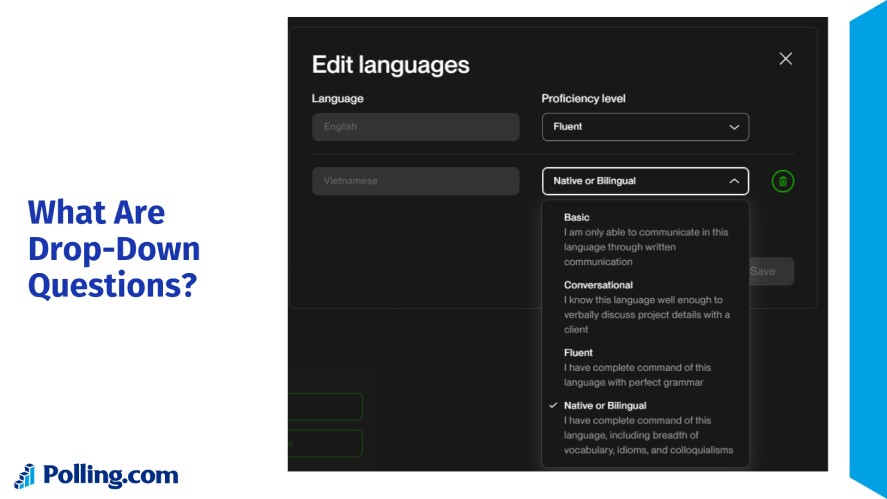
They’re best for cases with limited but distinct options.
For example, demographic questions for surveys like “Which state do you live in?” with 50 clear choices, friendly surveys where a compact drop down menu in Google Forms beats a long scroll of buttons.
These make them a go-to for free polls or quick random survey questions, keeping the experience smooth and the data sharp.
Drop-Down Questions vs. Other Question Types
Drop-down questions are just one of several survey question types used for single-response answers.
Compared to radio buttons, which show all options upfront, drop-downs keep your form cleaner by hiding options until clicked. This makes them ideal for long lists but less efficient for short, simple choices.
Checkboxes, on the other hand, allow multiple selections, while drop-downs typically only allow a single-select option unless custom-coded.
For quick decision-making or when visual clarity is important, multiple choice question formats (like radio buttons or sliders) may provide a better user experience than a drop-down.
Advantages of Using Drop-Down Questions
Drop-down questions bring some serious perks to your surveys, making them a standout among survey question types.
First off, they’ve got a clean, space-saving interface. Unlike a sprawling list of radio buttons, a drop-down tucks survey answer choices into a neat little box, keeping things tidy for respondents.
Plus, they lock it down to one pick, preventing multiple selections when you only want a single answer. It’s perfect for nailing down clear data without the mess.
Moreover, drop-down questions are ideal for long lists. Surveys like “Which country are you from?” with 200+ options or “What’s your job title?” where roles pile up can handle that without clogging the screen.
And on mobile? They shine and enhance usability by cutting scroll time, making them a top pick for polls or any survey where respondents are tapping away on their phones.
When to Use Drop-Downs for Question Branching
Drop-downs are especially useful for creating dynamic, personalized surveys through logic-based branching. When used correctly, they streamline the survey experience by hiding irrelevant questions and reducing cognitive load.
For example, in a customer feedback survey, a drop-down asking “Which product did you purchase?” can be used to display a tailored set of follow-up questions based on the selected product.
This method improves response accuracy and helps you collect more targeted data.
Drop-downs are ideal for branching when:
- You have distinct paths based on user segments (e.g., location, product type, job role).
- You want to avoid overwhelming the respondent with unnecessary questions.
- You’re using form field selection to segment audiences for analysis.
To implement this, most survey platforms let you assign rules like: “If answer to Question 2 is A, then show Question 3; otherwise skip to Question 5”.
Pro tip: Keep drop-down options mutually exclusive to avoid ambiguous branching paths. For example, avoid options like “Other/All of the above” unless you have a clear logic plan for them.
When NOT to Use Drop-Down Questions
Drop-down questions aren’t always the answer. There are times they can trip up your survey process instead.
For one, they bump up cognitive load. Since answers stay hidden until clicked, respondents might feel decision fatigue flipping through a long list, slowing them down or pushing random survey questions picks.
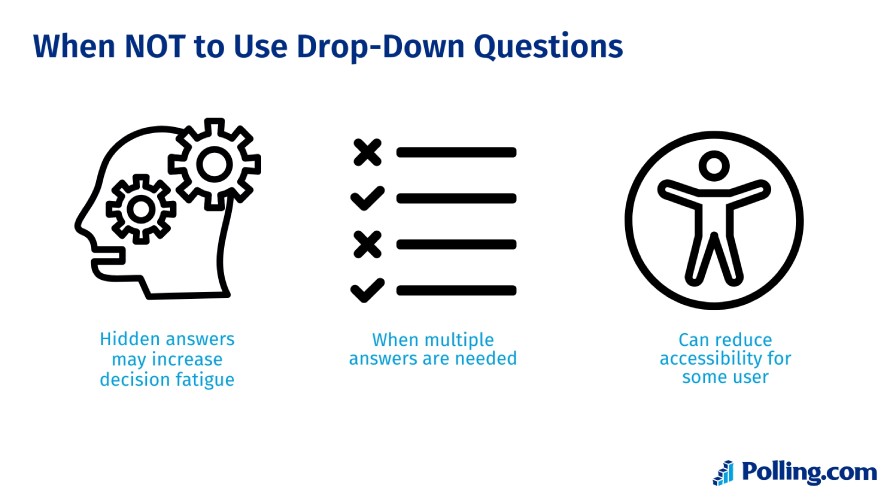
Then, they’re a no-go when multiple answers are needed. If you’re asking “What features do you like?” and want more than one, checkboxes beat drop-downs, which cap it at a single choice.
Also, accessibility can take a hit. Some respondents using keyboard navigation or screen readers might struggle with a Google form dropdown, making it less friendly than visible options.
So, for those cases, other question types for surveys might save you from losing good data or frustrating your crew.
Best Practices for Writing Effective Drop-Down Questions
Crafting drop-down questions that work takes a bit of know-how to keep respondents happy and your data clean.
First, keep the list of choices concise. Aim for 5-10 options max if possible, like “How often do you shop? (Daily, Weekly, Monthly, Rarely)” instead of a sprawling 20-item mess, so it’s easy on the eyes and brain.
Next, order them logically. Go alphabetical for stuff like “What’s your state?” or chronological for “What year did you start?” to make picking a breeze.
Also, use clear and distinct answer options. Swap vague options like “Sometimes” or “Often” for sharp options like “Once a week” or “Twice a month” to avoid overlap and nail those survey answer choices.
Finally, skip “Other” unless you pair it with a text input. Otherwise, you’re leaving respondents hanging with no way to explain, which muddies your types of survey questions data.
Common Mistakes to Avoid with Drop-Down Questions
Drop-downs can make your survey sleek and interactive, but only if used thoughtfully. Poor implementation can confuse respondents and skew results.
Here are common pitfalls to avoid.
Overloading with Too Many Options
One of the most frequent issues is overloading a drop-down with too many choices.
When respondents are faced with long, unorganized lists, especially those with more than 15–20 options, they may feel overwhelmed or skip the question entirely.
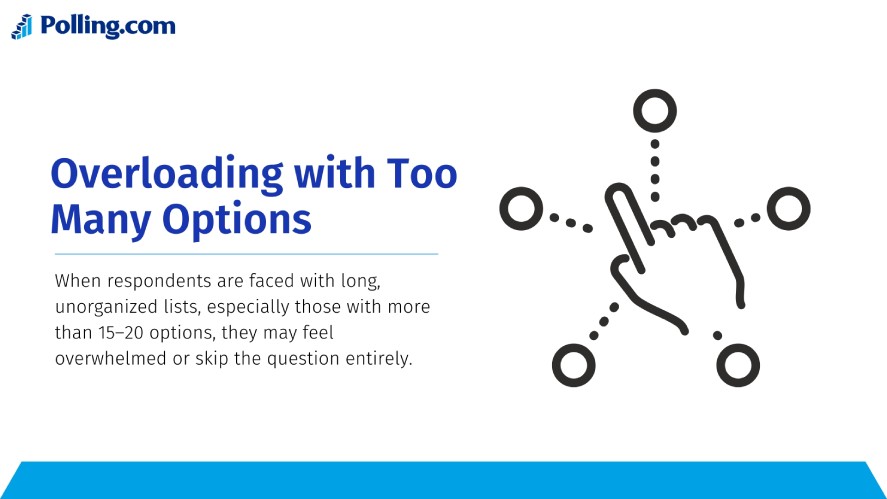
This is particularly problematic on mobile devices where scrolling through an extensive list is even more cumbersome.
To solve this, consider grouping items into subcategories or using cascading drop-downs that reveal more specific options based on a previous selection.
In some cases, replacing a long list with a searchable drop-down or autocomplete field can dramatically improve user experience.
Inconsistent Option Formatting
Poor formatting can make your options look unprofessional and harder to process.
For example, mixing capitalization styles (like “Male”, “FEMALE”, and “Prefer not to say”) or combining unrelated categories (such as gender and profession in one list) leads to visual clutter and confusion.
Formatting should be consistent in tone, structure, and style across all options. Decide whether you’ll use title case or sentence case, and stick with it.
Likewise, make sure all options are grammatically parallel. If one is a noun, all should be nouns. These small details improve clarity and reinforce trust in your survey.
Ambiguous or Unclear Labels
Another common pitfall is using vague or contextless labels in your drop-downs.
Generic options like “Other”, “Regular”, or “Level 3” can confuse respondents if they aren’t explained properly. The Other option should always be accompanied by a text field so users can elaborate.
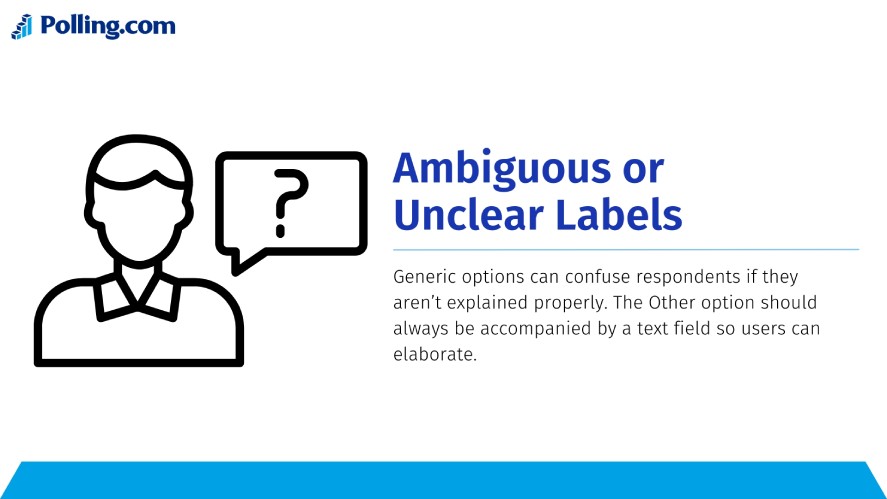
When using coded labels like levels or tiers, provide context in the question or tooltip to explain what each option represents.
Clear labeling reduces the risk of misinterpretation and ensures that the data you collect is reliable and meaningful.
Forcing Drop-Downs Where Other Formats Are Better
Not every question needs to use a drop-down. In fact, if your list contains just two to four options, a drop-down may actually make the question harder to answer.
With short lists, formats like radio buttons or visible multiple-choice answers are usually faster and more intuitive. These alternatives allow users to scan and respond at a glance without clicking through a menu.
Drop-downs are best reserved for situations where space is limited or when the list is too long to display effectively all at once.
Poor Logic in Branching
Drop-downs are often used in surveys that include branching or skip logic, but mistakes in how that logic is set up can create major user flow issues.
If an option leads to the wrong follow-up question, or worse, a dead end, respondents may abandon the survey or provide incorrect answers.
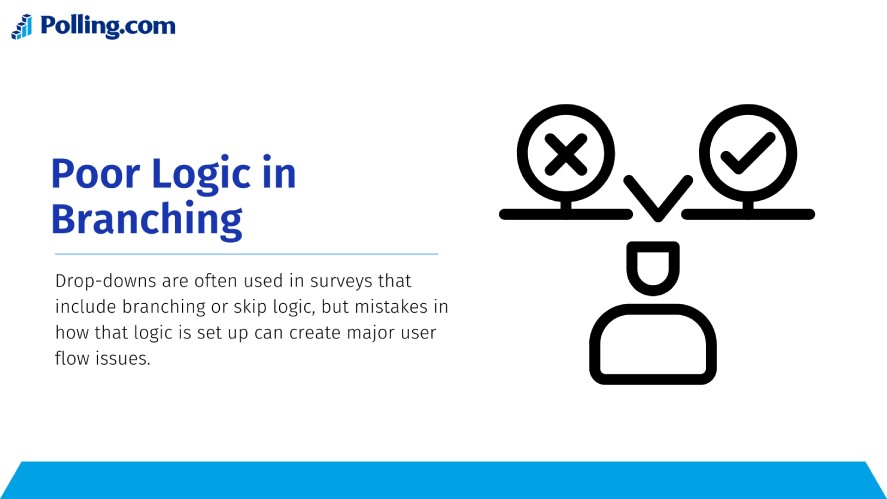
To avoid this, it’s critical to test every logic path thoroughly before launching the survey.
Use dummy responses to simulate different journeys through the survey and make sure that each option routes users to the right follow-up questions based on their selection.
Mobile-Unfriendly Behavior
Finally, a drop-down that works fine on desktop can behave poorly on smaller screens.
Mobile users may struggle with drop-downs that are too small, poorly spaced, or awkward to tap. Menus that open off-screen or overlap other content can also cause accidental selections or delays.
To prevent this, always preview and test your survey on various screen sizes and ensure your tool supports responsive design. Look for features like larger tap targets and collapsible menus that make interaction smoother on mobile.
A mobile-friendly drop-down not only improves user experience but can also reduce abandonment rates.
Examples of Drop-Down Questions in Action
Drop-down questions shine in all kinds of surveys. Here’s how they play out with respondents.
In an NPS survey, you might ask, “How likely are you to recommend us?” with a drop-down scale from 0-10. It’s a clean way to grab that key loyalty score without cluttering the screen.
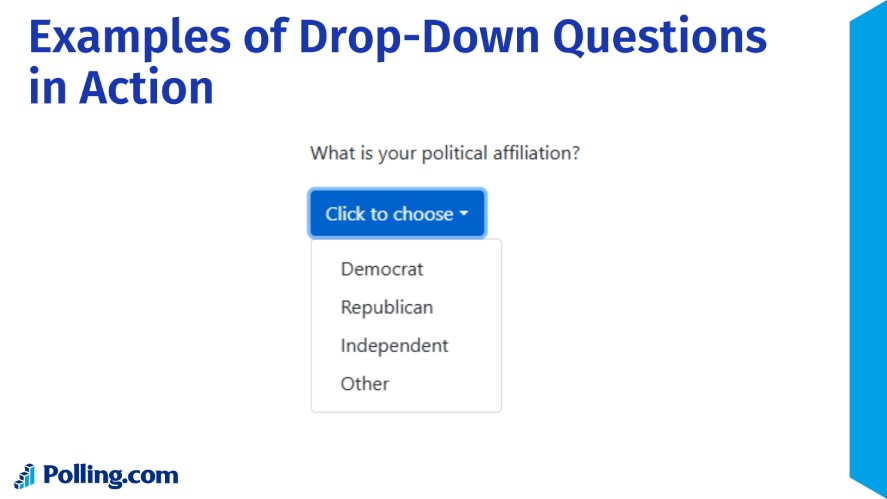
For a political survey, try “What is your political affiliation?” with options like Democrat, Republican, Independent, or Other. It’s a quick, tidy pick for demographic questions that keep the online poll moving.
Or in market research, go with “Which brand do you currently use for [product]?” listing brands like Nike, Adidas, or Puma in a drop-down. It’s ideal for long lists and pins down survey answer choices without overwhelming anyone.
These examples show how drop-downs fit into question types for surveys, making data collection smooth and sharp.
Are Drop-Down Questions Right for Your Survey?
So, are drop-down questions the move for your next survey?
They’ve got big wins and are perfect for long lists like demographics examples or multiple choice survey questions, keeping things easy for respondents and your data clean.
But they’re not flawless. Hidden options can tire respondents out, and they won’t work if you need multiple picks or top accessibility. Still, for the right job, like nailing down one clear answer fast, they’re a star among survey question types.
Frequently Asked Questions
Use drop-downs when you have more than 5–7 choices or want to save space. Radio buttons are better for short, simple, highly visible options.
Not by default. Most drop-down menus only allow one selection. For multiple answers, use checkboxes or a multi-select list field.
Stick to 10–15 items max. If you must include more, organize them alphabetically or by category, and include a search or “type to filter” option if possible.
